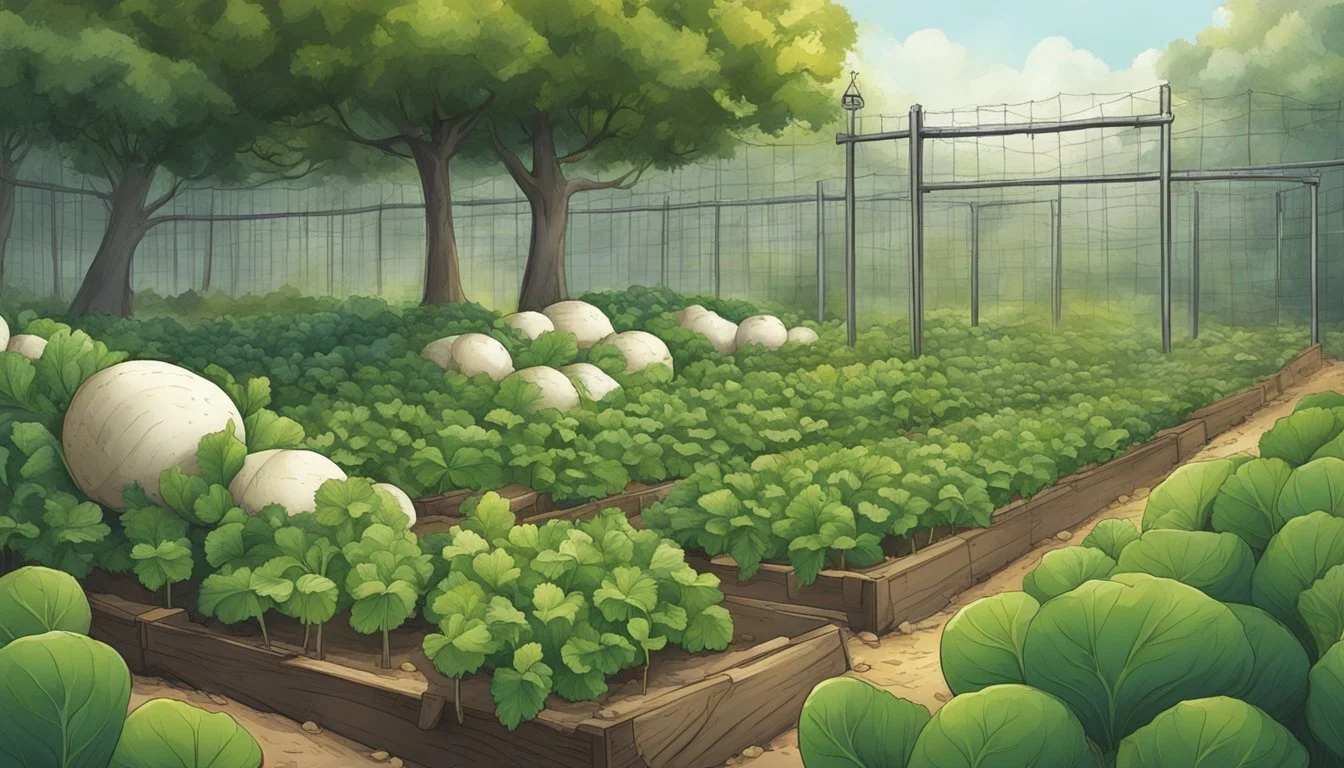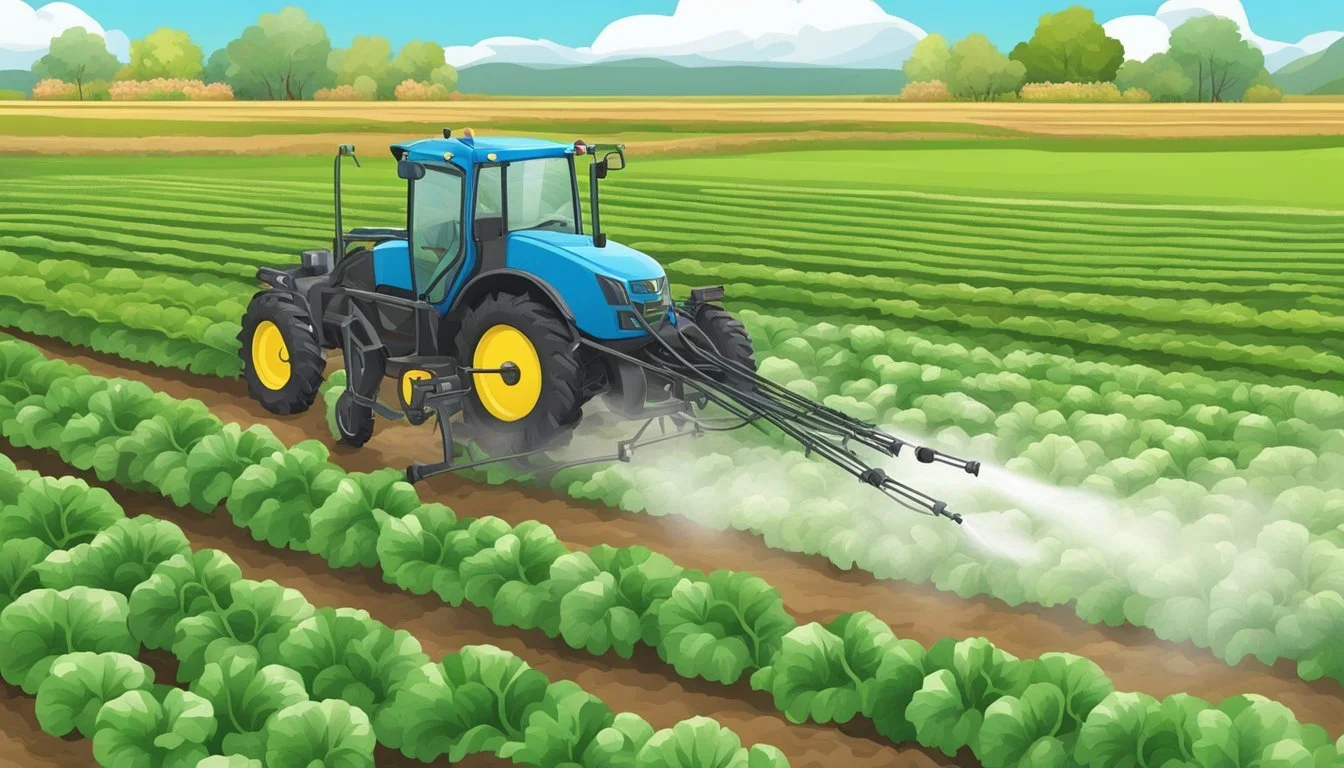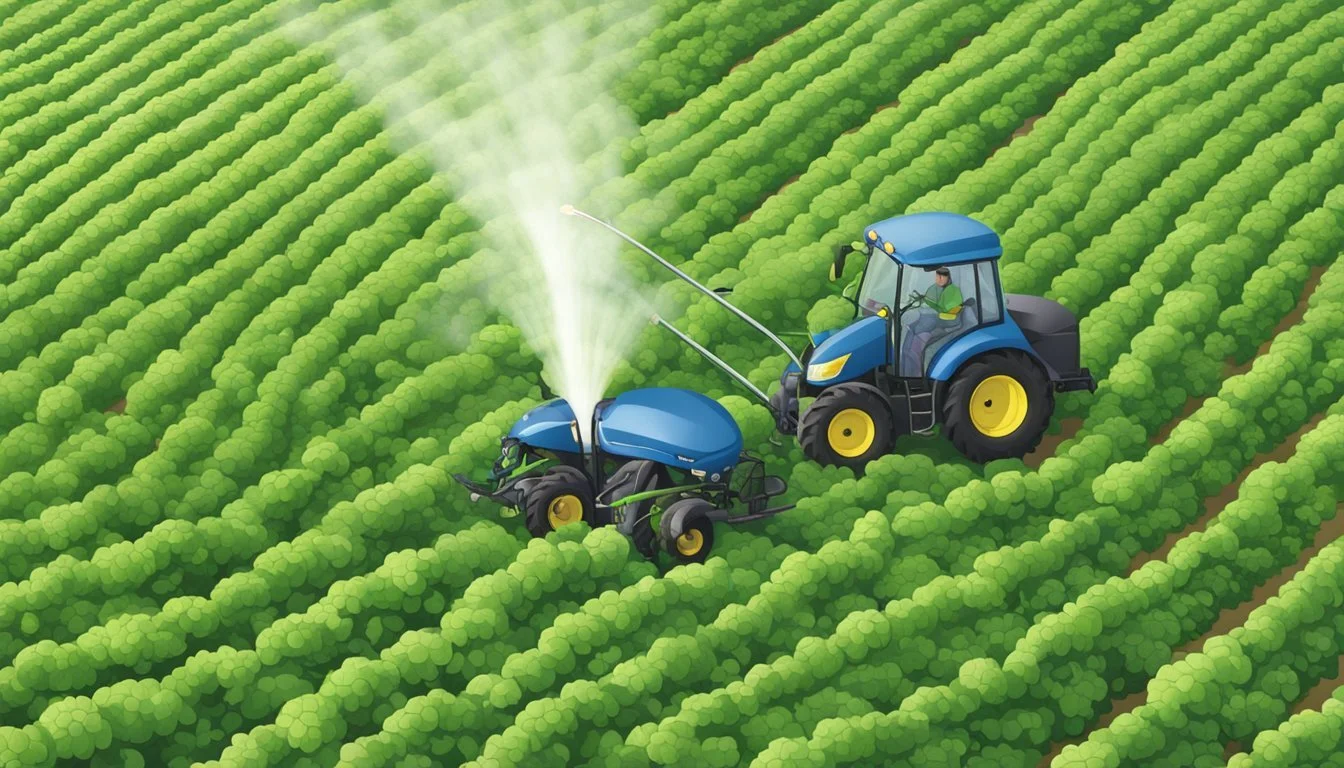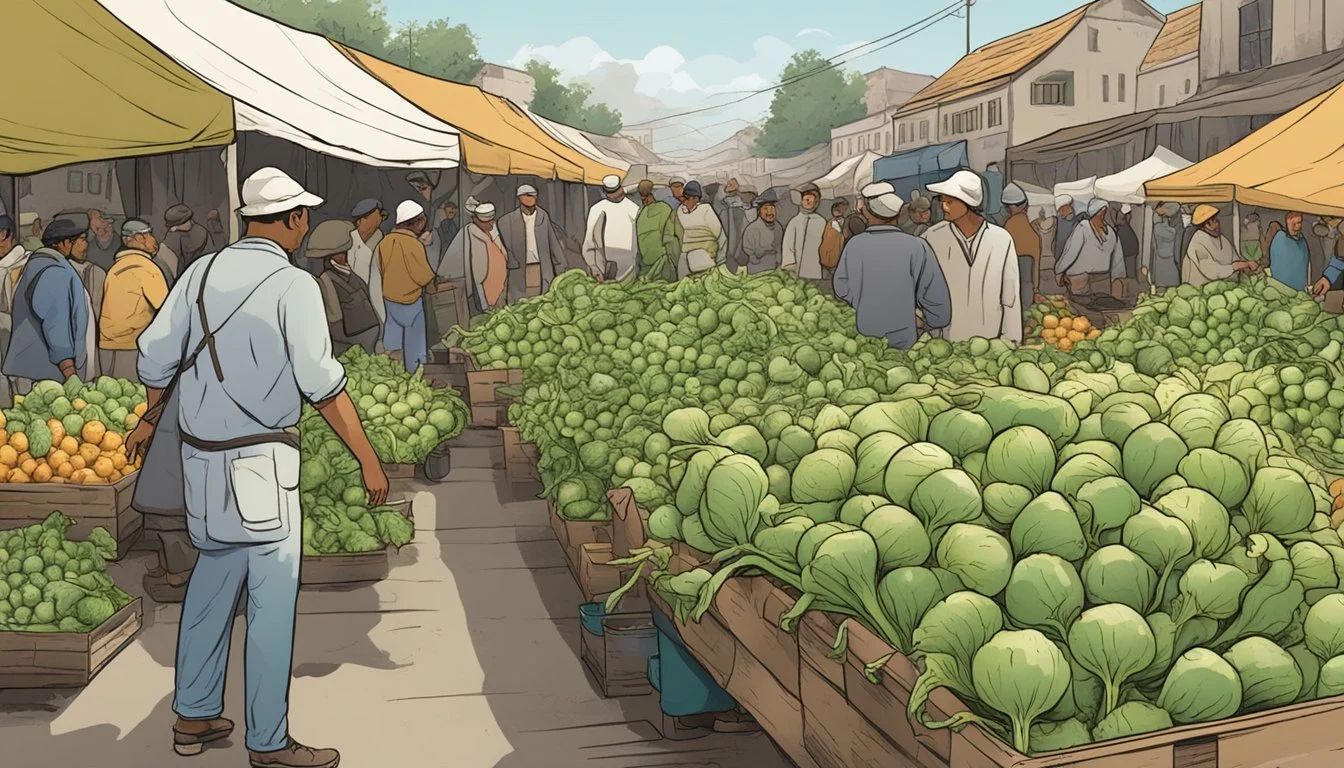Pest Control for Turnips
Effective Strategies to Protect Your Crop
Turnips, a hardy root vegetable, are a staple in many gardens due to their nutritional value and versatility in cooking. Growing turnips can be rewarding, but gardeners often face a challenge: pests. These insects and diseases can compromise the health and productivity of turnip crops if not managed properly.
To ensure a successful turnip harvest, it is crucial for gardeners to understand the common pests that affect these plants, such as aphids, flea beetles, and root maggots. Effective pest control starts with preventative measures, like crop rotation and proper soil management, to create an environment that is less appealing to pests. When infestations occur, identifying the specific pest is the first step towards implementing targeted control methods that can include both organic and chemical treatments.
In any garden, the goal is to balance pest control with environmental stewardship. By staying informed about the most current and effective control techniques, gardeners can protect their turnips from pests while maintaining a healthy, sustainable garden ecosystem.
Understanding Turnip Pests
Effective pest management is crucial for maintaining healthy turnip crops, as these root vegetables are susceptible to a variety of insect pests. Knowing which pests commonly affect turnips and understanding their life cycles are essential first steps in protecting your plants.
Identifying Common Pests
Turnips face threats from several insects which can hamper their growth and productivity. Aphids, small sap-sucking pests, can cause significant damage by weakening plants and can be recognized by their soft, pear-shaped bodies in various colors. Flea beetles, tiny jumping insects, create small holes in foliage, while whiteflies congregate in masses under leaves, leading to yellowing and wilting. Cutworms and cabbage loopers target the plant's base and leaves respectively, often visible at night. Slugs are non-insect pests that leave slime trails and uneven holes in leaves. Root-feeding pests like maggots and wireworms are hidden threats that dwell in the soil, damaging turnip roots.
Lifecycle of Turnip Pests
The lifecycle of these pests varies, but understanding it aids in timing control measures effectively. For instance,
Aphids: They reproduce rapidly, with multiple generations occurring in a single season. Their presence can be anticipated spring through fall.
Caterpillars (such as cabbage loopers): Emerge from eggs laid by moths or butterflies, going through stages from larvae to pupae before becoming adults.
Maggots (the larvae of flies): Develop within the soil after eggs are laid in the soil by adult flies.
Flea beetles: Overwinter in the soil or debris and emerge in warm weather to lay eggs near host plants.
Cutworms: Can overwinter as larvae or pupae in the soil, emerging in early spring to feed.
Whiteflies: Can reproduce throughout the year in warmer climates, perpetuating their lifecycle.
Each pest has distinct behavior and developmental stages, which are key to identifying the right control strategy at the right time.
Cultural Control Strategies
Cultural control strategies are essential for maintaining healthy turnip crops and managing pests. These methods leverage agricultural practices to create an environment that is less favorable for pests.
Soil Preparation
Proper soil preparation lays the foundation for healthy turnip growth. Incorporating organic matter such as compost or manure improves soil fertility and structure. It's crucial for the soil to have good drainage to prevent root diseases. Application of mulch can help retain moisture, regulate soil temperature, and suppress weed growth that could otherwise harbor pests.
Crop Rotation
Crop rotation is a pivotal aspect of pest management. Rotating turnips with unrelated crops each year reduces the chance of pest carryover, as many pests are crop-specific. This practice also helps to avoid depleting the soil of certain nutrients that turnips might use abundantly.
Planting Strategies
When planting turnips, spacing the seeds properly ensures adequate airflow, which minimizes the risk of fungal diseases. Using certified disease-free seeds can prevent the introduction of pathogens into the garden. Timing the planting to avoid peak pest seasons can also be a beneficial strategy.
Harvesting Techniques
Timely harvesting can prevent pests from multiplying and reduce the chance of diseases spreading. It is important to harvest turnip greens before the roots are mature if they are also being utilized. Monitoring the health of the crop regularly and harvesting at the first sign of maturity help prevent pests from causing significant damage.
Physical and Mechanical Controls
In the context of turnip pest management, physical and mechanical controls provide a safe and environmentally friendly means to reduce pest populations. These methods leverage barriers and manual interventions to protect the crop.
Row Covers and Barriers
Row covers act as a physical shield, protecting turnips from various pests. They're usually made of lightweight, translucent material like spunbonded polypropylene which lets sunlight in but keeps insects out. When installed properly, row covers can deter pests such as aphids and flea beetles.
Reflective mulch, another barrier technique, confuses pests like aphids that rely on visual cues to locate turnip plants. This mulch's shiny surface reflects light, disorientating pests and reducing their ability to land on and infest crops.
Hand Picking and Traps
Hand picking pests from turnip plants is as straightforward as it sounds, but it requires diligence. Gardeners often remove pests like the cabbage aphid by regularly inspecting plants and literally picking them off.
Traps come in many forms, from sticky tape for flying insects to ground-level traps for slugs. They're placed strategically around the turnip patch to capture or eliminate pests before they can cause significant damage.
Implementing tillage can help destroy the habitat of soil-dwelling larvae and pupae, reducing the likelihood of pest emergence. However, the timing of tillage is critical to avoid harming beneficial organisms or turnip roots.
Biological Control Methods
Biological control methods leverage nature's own mechanisms for managing pest populations in turnip crops. They focus on introducing or enhancing the populations of natural enemies of turnip pests.
Beneficial Insects and Nematodes
Beneficial Insects: Turnip growers can introduce beneficial insects like soldier beetles, ladybug beetles, and lacewings to control destructive pests. Ladybugs, in particular, are voracious predators of aphids and other soft-bodied insects that can severely damage turnip leaves. A healthy population of these beneficial insects can significantly reduce pest numbers through predation.
Examples of Beneficial Insects:
Ladybugs: Known for aphid control
Soldier Beetles: Feed on a variety of insect pests
Lacewings: Larvae consume large quantities of soft-bodied pests
Beneficial Nematodes: These microscopic organisms can play a pivotal role in pest control for turnips. Beneficial nematodes target soil-dwelling larvae of various pest species without harming the plants or beneficial insects. They enter the bodies of pest larvae and release bacteria that kill the host. This provides a natural and effective method for controlling subterranean pests that are often difficult to manage with other control measures.
Examples of Beneficial Nematodes:
Steinernema spp.: Effective against various caterpillars and borers
Heterorhabditis spp.: Known for its ability to control grubs and weevils
Biological control is an integral part of sustainable turnip farming, helping to maintain an ecological balance and reduce reliance on chemical pesticides. By adopting these practices, farmers can effectively manage pests in a way that is both environmentally friendly and conducive to producing healthy turnip crops.
Chemical Control Measures
When organic methods fall short, chemical control measures against pests in turnip crops can be effective. Understanding the insecticides available and proper application practices is critical for successful pest management.
Insecticide Options
For turnips, several insecticides can be considered to target specific pests. Neem oil and insecticidal soaps are less harsh options, often used for controlling smaller infestations of soft-bodied insects. More severe infestations may require the use of bacillus thuringiensis (Bt), a microbial insecticide that is effective against caterpillar pests. Horticultural oils can suppress mites and aphids by suffocating them. In addition, there are more potent chemicals like spinosad, carbaryl, and permethrin, which are broad-spectrum insecticides offering more extensive control over a variety of pests affecting turnips.
Insecticide Type Target Pests Notes Neem Oil Aphids, Mites Organic; acts as a repellent Insecticidal Soap Soft-bodied insects Contact insecticide; organic Bt (Bacillus thuringiensis) Caterpillars Biological control; selective Horticultural Oils Aphids, Mites Suffocates pests; minimal toxicity Spinosad Broad range of insects Derived from natural substances Carbaryl Broad spectrum control Caution advised due to toxicity Permethrin Broad spectrum control Synthetic; highly effective
Application Best Practices
Proper application is as crucial as selecting the right insecticide. Always follow label instructions to ensure safety and effectiveness. Insecticides should be applied either in the early morning or late evening to minimize the impact on beneficial insects and reduce the risk of burning the plants. It's important to rotate chemical classes to prevent pest resistance; do not rely solely on one type of insecticide.
Always wear protective clothing when applying insecticides.
Calculate the correct dosage and thoroughly cover the impacted areas.
Avoid applying insecticides before rain to prevent runoff.
Consider environmental impact and the presence of non-target species.
By adhering to these best practices, farmers can manage pest populations effectively while minimizing harm to ecosystems and beneficial organisms.
Turnip Plant Care
Proper care of turnip plants involves attentive watering, feeding, and disease management to ensure healthy growth. Below are specific practices to follow:
Watering and Feeding
Turnips require consistent moisture, particularly when seeds are germinating and when plants are growing. They should be watered deeply at least once a week, or more often during dry spells, ensuring the soil does not dry out completely. For feeding, a balanced fertilizer can promote vigorous growth; however, it's important to avoid high nitrogen fertilizers which can lead to leafy growth at the expense of the root.
Watering Schedule: Weekly deep watering
Fertilizer: Balanced, applied per product instructions
Disease Management
Managing diseases in turnip crops involves both preventative measures and treatment strategies. Here are some common issues and how to address them:
Clubroot: Prevent by maintaining a soil pH around 7.2. Once present, infected plants should be removed and destroyed.
White Mold: Improve air circulation around plants and avoid overhead watering to prevent the damp conditions that mold thrives in.
Alternaria Leaf Spot: Rotate crops and use fungicide treatments as necessary.
Black Rot: Keep the garden free of plant debris and rotate crops annually.
Downy Mildew: Use resistant varieties and apply appropriate fungicides when needed.
Viral Diseases: Remove and discard any infected plants immediately to prevent spread.
Disease Prevention Tips:
Maintain proper soil pH
Ensure good air circulation
Implement crop rotation
By following these structured care procedures, one can minimize the risk of disease and encourage the healthy growth of turnip plants.
Monitoring and Responding to Infestations
Effective pest management in turnip cultivation relies on early detection of infestations, evaluation of control measures, and consistent monitoring. These steps are critical in preventing extensive damage to the plants, which typically manifests in the degradation of crucial plant parts such as stems, leaves, and petioles, as well as the root crops themselves.
Early Detection
To safeguard turnip crops, one must meticulously examine plants for the earliest signs of pest invasion. They should especially focus on the undersides of leaves and the base of the plant, as these areas are common targets for pests. Symptoms to watch for include leaves that turn yellow, swollen stems, and petioles. It is vital to identify issues when they are manageable, as symptoms can quickly escalate, with pests leading to circular damage patterns that may enlarge to form concentric rings or V-shaped lesions.
Control Measure Evaluation
Upon detecting an infestation, it's critical to assess the effectiveness of any control measures applied. Gardeners and farmers should evaluate pest control chemicals or natural deterrents to ensure they are not causing additional harm to the plants or the environment. For root crops like turnips, assessing the health of the crop may involve pulling a few samples to check for damage such as feeding tunnels or rot, which may indicate the presence of pests such as the cabbage root fly, as noted in this guide on managing Turnips pests and diseases.
Continuous Monitoring
Consistent monitoring throughout the growing season is an ongoing process that helps in adjusting pest control strategies based on the current situation. This involves a routine schedule of checking the crops for any changes or exacerbation of symptoms. Farmers must maintain vigilance for new infestations, monitor the size and health of the plant population, and note any alterations in pest behavior or population dynamics.
Sustainable Pest Management
Sustainable pest management for turnips is critical for ensuring the long-term health of both the crops and the environment. It utilizes practices that reduce reliance on chemical pesticides and promotes ecological balance.
Integrated Pest Management Practices
Integrated Pest Management (IPM) is a cornerstone of sustainable pest control for turnips, focusing on long-term prevention and control strategies. It is composed of several key components:
Monitoring: Regular inspection of turnip crops for signs of pest activity is essential for timely intervention.
Identification: Accurate identification of pests ensures the correct management methods are employed and non-target species are not affected.
Threshold Levels: Establishing action thresholds determines the point at which pest populations warrant control measures.
Control Methods: A variety of control techniques are considered, including:
Cultural controls: Crop rotation and sanitation to disrupt pest life cycles.
Mechanical controls: Physical barriers or traps.
Biological controls: Introducing natural predators or parasites of the turnip pests.
Chemical controls: Application of pesticides as a last resort and done so in a manner that minimizes environmental impact.
Turnip growers aim to apply IPM methods to maintain pest populations below levels that can cause significant economic harm while preserving ecological integrity. One may find practical guidance on identifying turnip pests like the aphids mentioned in What's Eating My Turnips? How to Eradicate Turnip and Rutabaga Pests, which is crucial for IPM success.
Post-Harvest Pest Control
Effective post-harvest pest control is paramount to ensure the quality and longevity of turnips during storage. Proper techniques can safeguard the crop from common pests, maintaining the value for vendors and satisfaction for consumers.
Storage Techniques
Temperature Regulation: Storing turnips at low temperatures can drastically reduce the occurrence of pests. For example, research has indicated that certain larvae are killed when apples are stored at 0°C, suggesting similar practices can be beneficial for turnips.
Controlled Atmosphere: A precise balance of oxygen and carbon dioxide within storage facilities can be utilized to deter pests. Techniques might involve increasing carbon dioxide levels which has been shown to be fatal to pests such as two-spotted spider mites on kiwifruit.
Cleansing and Maintenance: Prior to placing turnips in storage, it is crucial to ensure that the facilities are cleaned and free of residual pests. Regular inspections and maintenance prevent infestations and support optimal storage conditions.
Physical Barriers: Utilizing screens and filters can physically block pests from entering storage areas, which is a non-chemical approach often preferred by organic gardening standards.
Inert Materials: For organic post-harvest pest control, it's essential to use materials compliant with regulations, such as those not listed at §205.602 for synthetics. Guidance on organic storage pest control can provide vendors with permissible options.
Through implementing temperature control, leveraging controlled atmosphere storage techniques, and ensuring clean and secure environments, turnips can be effectively protected from pests after harvest. These best practices contribute to the longevity of the produce and support the commitment to quality upheld by both growers and vendors in the gardening and agricultural commissions.
Marketplace Considerations
When selling turnips, comprehending the implications of pest control measures is essential for marketplace success. This involves adhering to stringent regulations, ensuring proper labeling for consumer transparency, and meticulously selecting vendors that align with high standards.
Labeling and Regulations
Labeling: It's crucial that turnips affected by pests are accurately labeled. This includes specifying if any pesticides have been used and, if so, ensuring that they are within the legal limits set by agricultural commissions. Consumers demand to know what's on their food and how it's been treated, which influences their purchasing decisions.
Regulations: Vendors and garden owners must follow local and international regulations regarding pest control. These regulations often require detailed documentation, periodic checks, and adherence to safe pesticide use. Non-compliance could result not only in fines but also a loss of trust and business.
Vendor Selection
When choosing vendors, it's important to assess their pest control strategies:
Experience: Experienced vendors likely have proven pest control methods that comply with regulations.
Reputation: A vendor's reputation can indicate their commitment to quality and safe practices.
Methodology: Vendors should use pest control methods that preserve the quality of the turnips while ensuring the safety of consumers.
Each vendor's approach will reflect on the marketplace, affecting both the perceived value of the produce and the trust consumers place in purchasing healthy, sustainable turnips.
Frequently Asked Questions
This section aims to address common concerns and provide practical solutions to protect turnip crops from pests and diseases.
How can I create effective homemade pest control solutions for turnip plants?
One can create homemade pest deterrents using ingredients like neem oil or a mixture of soap and water. Applying these solutions can help manage minor infestations without the use of harsh chemicals.
What are the best commercial pest control products suitable for turnips?
Commercial products that are safe for turnip plants include insecticidal soaps and neem oil-based pesticides. Always follow label instructions to ensure effectiveness and crop safety.
What are common pests and diseases affecting turnip crops?
Turnips are commonly affected by flea beetles, aphids, and root maggots. Diseases like downy mildew and white rust can also impact turnip health.
Why are the leaves of my turnip plants getting eaten and how can I stop it?
The leaves of turnip plants are often eaten by flea beetles and caterpillars. To stop them, one can use floating row covers or apply organic pesticides that target these pests.
How can turnip aphids be effectively controlled or eradicated?
To control or eradicate aphids on turnip plants, introduce natural predators like ladybugs or apply insecticidal soap sprays to affected areas.
What are the symptoms and treatment for boron deficiency in turnips?
Symptoms of boron deficiency in turnips include stunted growth and hollow stems. To treat the deficiency, one can apply a boron supplement according to soil test recommendations.







